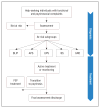The psychosis high-risk state: a comprehensive state-of-the-art review
- PMID: 23165428
- PMCID: PMC4356506
- DOI: 10.1001/jamapsychiatry.2013.269
The psychosis high-risk state: a comprehensive state-of-the-art review
Abstract
Context: During the past 2 decades, a major transition in the clinical characterization of psychotic disorders has occurred. The construct of a clinical high-risk (HR) state for psychosis has evolved to capture the prepsychotic phase, describing people presenting with potentially prodromal symptoms. The importance of this HR state has been increasingly recognized to such an extent that a new syndrome is being considered as a diagnostic category in the DSM-5.
Objective: To reframe the HR state in a comprehensive state-of-the-art review on the progress that has been made while also recognizing the challenges that remain.
Data sources: Available HR research of the past 20 years from PubMed, books, meetings, abstracts, and international conferences.
Study selection and data extraction: Critical review of HR studies addressing historical development, inclusion criteria, epidemiologic research, transition criteria, outcomes, clinical and functional characteristics, neurocognition, neuroimaging, predictors of psychosis development, treatment trials, socioeconomic aspects, nosography, and future challenges in the field.
Data synthesis: Relevant articles retrieved in the literature search were discussed by a large group of leading worldwide experts in the field. The core results are presented after consensus and are summarized in illustrative tables and figures.
Conclusions: The relatively new field of HR research in psychosis is exciting. It has the potential to shed light on the development of major psychotic disorders and to alter their course. It also provides a rationale for service provision to those in need of help who could not previously access it and the possibility of changing trajectories for those with vulnerability to psychotic illnesses.
Conflict of interest statement
Figures






Comment in
-
Bayesian analysis of posttest predictive value of screening instruments for the psychosis high-risk state.JAMA Psychiatry. 2013 Aug;70(8):880-1. doi: 10.1001/jamapsychiatry.2013.1320. JAMA Psychiatry. 2013. PMID: 23925303 No abstract available.
References
-
- Klosterkötter JGG, Huber G, Wieneke A, Steinmeyer EM, Schultze-Lutter F. Evaluation of the Bonn Scale for the Assessment of Basic Symptoms: BSABS as an instrument for the assessment of schizophrenia proneness: a review of recent findings. Neurol Psychiatry Brain Res. 1997;5:137–150.
-
- Fusar-Poli P, Borgwardt S, McGuire P. Vulnerability to Psychosis: From Neurosciences to Psychopathology. London, United Kingdom: Psychology Press; 2011.
-
- Fusar-Poli P, Yung AR. Should attenuated psychosis syndrome be included in DSM5? Lancet. 2012;379(9816):591–592. - PubMed
-
- Yung AR, Phillips LJ, Yuen HP, Francey SM, McFarlane CA, Hallgren M, McGorry PD. Psychosis prediction: 12-month follow up of a high-risk (“prodromal”) group. Schizophr Res. 2003;60(1):21–32. - PubMed
Publication types
MeSH terms
Grants and funding
LinkOut - more resources
Full Text Sources
Other Literature Sources
Medical
Miscellaneous

